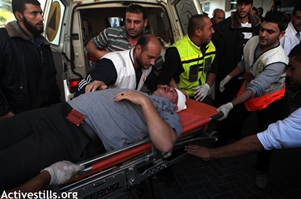
On the evening of the third day of the attack on Gaza Strip, Physicians for Human Rights began receiving worrisome and severe reports regarding the obstruction of the activity of emergency and rescue teams.
Dr. Bashar Murad, the director of the emergency and rescue services of the Red Crescent in Gaza, reported to Physicians for Human Rights representatives about the difficulties and risks facing the rescue teams: “although there is no direct harm to the emergency services and centers, the proximity to the bombings, in particular those in the open areas in Gabalia, next to the emergency center, causes great harm. Heavy shrapnels sharp edged fragments, some weigh 5 kilo, hit the center. With no advanced warnings, there is no possibility of evacuation prior to the bombing.”

A Palestinian injured in the head is rushed into Al Shifa hospital, Gaza city, November 15, 2012 (Photo: Activestills)
“The destruction of infrastructure, such as roads, causes difficulties and delays reaching the wounded. In some cases the blocked roads, created by potholes resulting from bombings, or demolished houses blocking streets, do not allow clear transfer of ambulances. Thus, the paramedics are required to walk and carry the wounded while endangering their lives and arriving to the wounded with delay, with time being of the essence, creating the difference between life and death”.
“One of the greater risks occurs when a place is being bombed for the second time, after rescue teams have arrived on location. There were some cases in which the same place was being bombed twice within a small time difference. This put rescue teams in grave danger. In one such incident, two paramedics were indeed wounded from shrapnels whilst evacuating citizens, under fire.”
“As a result of the ongoing bombings, the rescue teams of the Red Crescent and the emergency centers and clinics, were vastly damaged, in a mild to moderate manner in the area of Telhawa and El-Quds hospital. Most windows broke; some of the interior and external roofs had collapsed or were partly damaged as a result of the shock waves of the bombings (not as a result of a direct hit). Many of the patients feel under threat and fearful in a place where they are ought to be cared for and safe”.
“The emergency and rescue building in Jabalia was damaged as well, including its treatments rooms, emergency call center and offices. All the windows broke and the building was damaged on the exterior”.
It is important to note that during deadly Operation ‘Cast Lead’, members of medical teams were injured in the course of action, while providing medical treatment and evacuating wounded. Wounded individuals in need of evacuation were left for many hours besieged in their house, due to inability of medical teams to reach them, as they were in fear of their lives, and under ongoing bombings.
Related:
http://www.phr.org.il/default.asp?PageID=190&ItemID=1642


